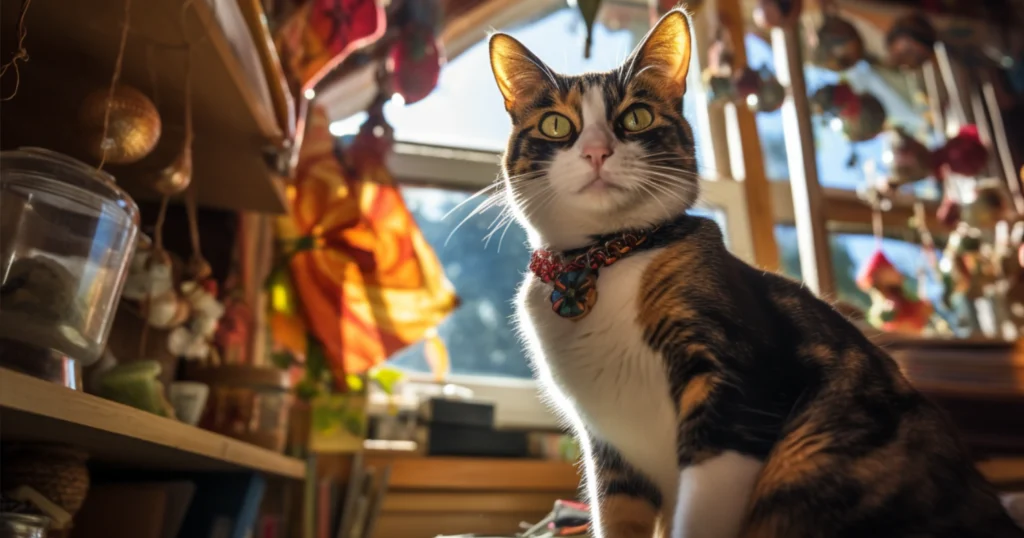Calico cats are easily recognized by their distinctive tri-colored fur coats – a patchwork of orange, black, and white. This striking pattern makes calicos extremely popular, especially among cat lovers and breeders. But are calico cats actually rare, or are they just highly sought-after for their beauty? That’s the key question we’ll explore in this article.
As we’ll discuss, genetics plays a major role in producing the calico’s one-of-a-kind look. From this genetic link arises calicos’ female predominance along with their limited numbers. So while they may not be the rarest of cats, calicos’ unique blend of genetic quirks makes them uncommon and special.
What Makes a Cat a Calico?

Definition of a Calico Cat
Calico isn’t a breed, but a color pattern. Calico cats boast a unique coat splashed with three colors – generally white, black, and orange. The name ‘Calico’ is inspired by color-splashed textiles from Calicut, India. The calico coat is defined by a distinctive patchwork pattern of orange, black, and white fur. No two calicos have exactly the same swirls and spots of color distributed throughout their fur.
Variations in Calico Patterns
Though we generally think of the classic black, orange, and white, calico patterns aren’t just restricted to these colors. You might spot calicos sporting softer hues of cream and reddish-brown or even smoky grey-blue patches. Their coats can be speckled, splotched, or marbled, with each pattern as unique as a fingerprint.
Calico Cats and Gender
Due to genetic conditions, calicos are almost exclusively female. The orange gene is carried on the X sex chromosome. For a cat to visually display calico colors, they must have XX chromosomes, like a female cat. Male calicos with XXY chromosomes do exist but are extremely rare.
The Rarity of Calico Cats

Rarity of Male Calico Cats
The sight of a male calico cat is as rare as a blue moon. Remember how calico coloring needs two X chromosomes? Well, typical male cats have just one X, and one Y. So, where do male calicos come from? Cue a unique genetic condition: XXY Syndrome, or Klinefelter’s Syndrome. In these rare instances, male cats end up with an extra X chromosome, making the calico coloring possible. However, this special combination occurs in only about 1 in every 3,000 calico cats. Talk about a rare breed!
Geographic Distribution of the Orange Mutant Gene
The specific mutant orange gene responsible for the calico’s orange patches originated in cats from Egypt. This is why calicos became more common in port cities along the Mediterranean where cats traveled on ships from Egypt. Even today, the proportion of calico cats traces back to this geographic origin. Countries like Turkey and Greece have higher calico populations, while Northern Europe and Asia have fewer calicos since the orange gene spread less to those areas.
Calicoes in Different Cat Breeds

Cat Breeds More Likely to Present the Calico Pattern
Certain cat breeds are more prone to having calico-patterned members, including the American Shorthair, British Shorthair, Persian, Turkish Angora, and Japanese Bobtail. These breeds have a higher frequency of the orange color gene compared to other breeds. Still, calicos remain relatively uncommon representations even among breeds where they are most prevalent.
Rarity Across These Breeds
Even within these calico-prone breeds, the tri-color pattern isn’t a given; it’s a delightful surprise. Considering the genetic lottery that must occur to result in a calico, they’re less common than cats of a single color or two-color mixes. Within the American Shorthair breed, for example, calicoes are a small fraction of the population. British and Persian breeders also report calicoes as less common. So, while you might have a slightly higher chance of finding a calico among these breeds, they still remain a rare sight to behold.
Conclusion
In the cat world, calicos are certainly unique. Their distinctive patched coats of orange, black, and white set them apart. This rare color combination stems from genetic quirks like the orange gene and XX chromosomes. While calicos may be more common in certain breeds, overall they represent a small minority of the general cat population.
So in the end, yes calico cats are quite rare! Their gorgeous blended coloring is a result of unusual genetics that makes them stand out. Calicos will likely always be an uncommon sight among cats. But that rarity is part of their appeal to cat lovers who are lucky enough to share their lives with these beautifully bizarre kitties. When you spot a calico, enjoy their uniqueness and rarity!


